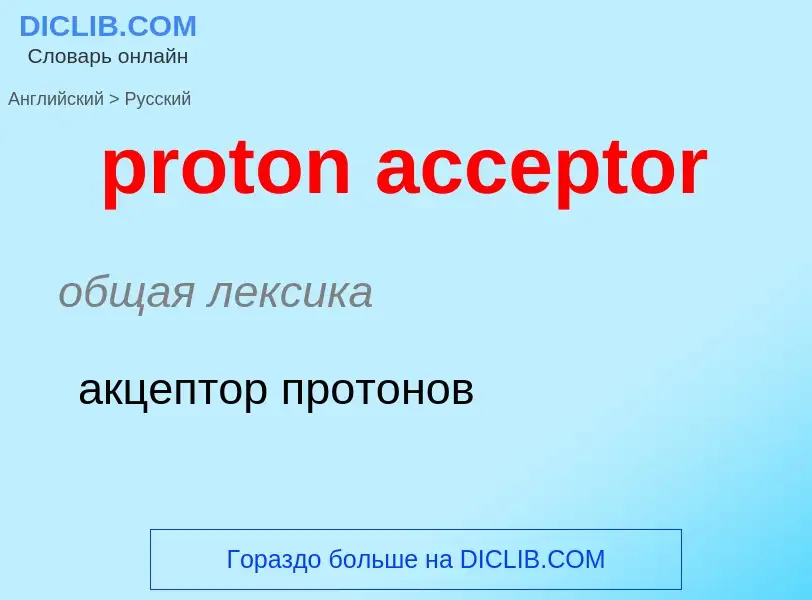Translation and analysis of words by ChatGPT artificial intelligence
On this page you can get a detailed analysis of a word or phrase, produced by the best artificial intelligence technology to date:
- how the word is used
- frequency of use
- it is used more often in oral or written speech
- word translation options
- usage examples (several phrases with translation)
- etymology
proton acceptor - translation to russian
общая лексика
акцептор протонов
[bei'sisiti]
химия
основность
валентность
существительное
химия
валентность
основность
валентность, основность
Definition
Wikipedia

In chemistry, there are three definitions in common use of the word base, known as Arrhenius bases, Brønsted bases, and Lewis bases. All definitions agree that bases are substances that react with acids, as originally proposed by G.-F. Rouelle in the mid-18th century.
In 1884, Svante Arrhenius proposed that a base is a substance which dissociates in aqueous solution to form hydroxide ions OH−. These ions can react with hydrogen ions (H+ according to Arrhenius) from the dissociation of acids to form water in an acid–base reaction. A base was therefore a metal hydroxide such as NaOH or Ca(OH)2. Such aqueous hydroxide solutions were also described by certain characteristic properties. They are slippery to the touch, can taste bitter and change the color of pH indicators (e.g., turn red litmus paper blue).
In water, by altering the autoionization equilibrium, bases yield solutions in which the hydrogen ion activity is lower than it is in pure water, i.e., the water has a pH higher than 7.0 at standard conditions. A soluble base is called an alkali if it contains and releases OH− ions quantitatively. Metal oxides, hydroxides, and especially alkoxides are basic, and conjugate bases of weak acids are weak bases.
Bases and acids are seen as chemical opposites because the effect of an acid is to increase the hydronium (H3O+) concentration in water, whereas bases reduce this concentration. A reaction between aqueous solutions of an acid and a base is called neutralization, producing a solution of water and a salt in which the salt separates into its component ions. If the aqueous solution is saturated with a given salt solute, any additional such salt precipitates out of the solution.
In the more general Brønsted–Lowry acid–base theory (1923), a base is a substance that can accept hydrogen cations (H+)—otherwise known as protons. This does include aqueous hydroxides since OH− does react with H+ to form water, so that Arrhenius bases are a subset of Brønsted bases. However, there are also other Brønsted bases which accept protons, such as aqueous solutions of ammonia (NH3) or its organic derivatives (amines). These bases do not contain a hydroxide ion but nevertheless react with water, resulting in an increase in the concentration of hydroxide ion. Also, some non-aqueous solvents contain Brønsted bases which react with solvated protons. For example in liquid ammonia, NH2− is the basic ion species which accepts protons from NH4+, the acidic species in this solvent.
G. N. Lewis realized that water, ammonia, and other bases can form a bond with a proton due to the unshared pair of electrons that the bases possess. In the Lewis theory, a base is an electron pair donor which can share a pair of electrons with an electron acceptor which is described as a Lewis acid. The Lewis theory is more general than the Brønsted model because the Lewis acid is not necessarily a proton, but can be another molecule (or ion) with a vacant low-lying orbital which can accept a pair of electrons. One notable example is boron trifluoride (BF3).
Some other definitions of both bases and acids have been proposed in the past, but are not commonly used today.


![[[Barium hydroxide]] [[Barium hydroxide]]](https://commons.wikimedia.org/wiki/Special:FilePath/BARIUM HYDROXIDE IMAGE.jpg?width=200)
![beaker]]) to produce [[ammonium chloride]] (white smoke). beaker]]) to produce [[ammonium chloride]] (white smoke).](https://commons.wikimedia.org/wiki/Special:FilePath/Hydrochloric acid ammonia.jpg?width=200)
